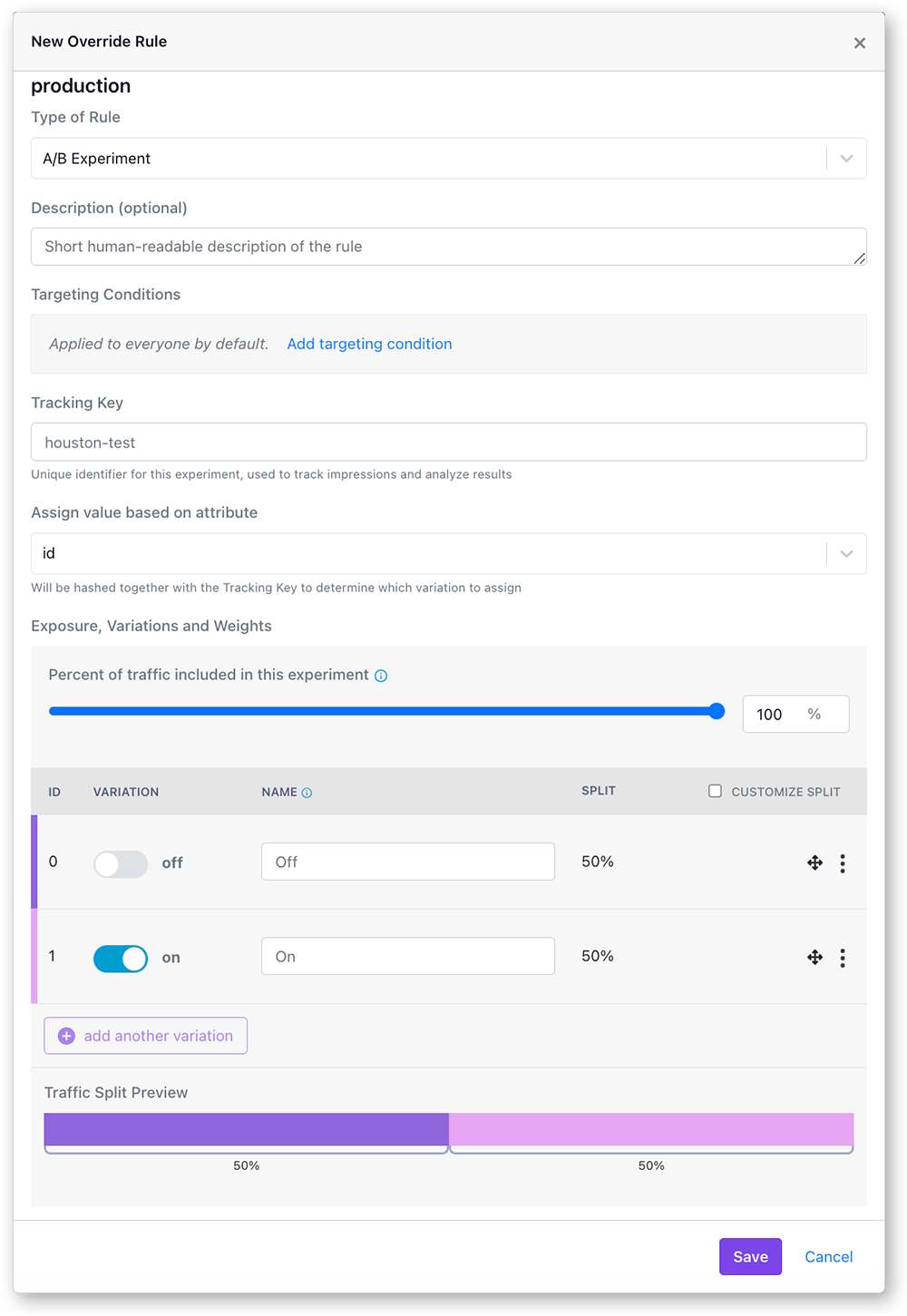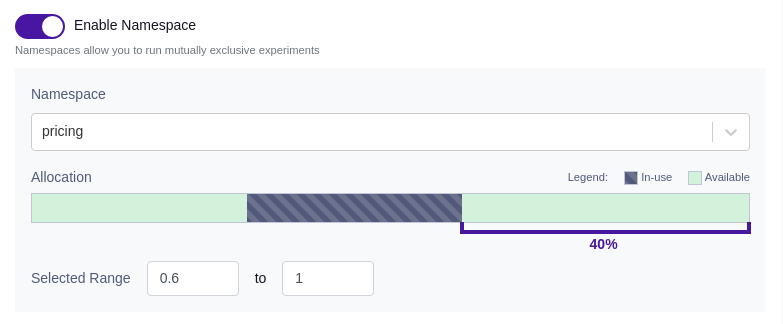Feature Flag Experiments
GrowthBook allows you to run experiments using feature flags. This method of running experiments allows any feature to be released as an A/B test. It is ideal for more complex experiments requiring multiple code changes, or for companies that want to have an experimentation development culture, and determining the impact on your metrics of any feature or code change.
Running Experiments with Feature Flags
Feature flag experiments are created with an experiment override rule. This experiment rule will randomly assign
variations to your users based on the configurations you select. When a user is placed in an experiment via an experiment
override rule, the assignment will be tracked in your data warehouse using the trackingCallback defined in the SDK
implementation.
Here's what an Experiment rule looks like in the GrowthBook UI:

This modal window allows for a great deal of flexibility and customization in how you run your experiments. Let's go through each of the options:
Experiment Targeting Conditions
Experiment rules can be targeted at specific user or client attributes. Only users who match the targeting condition will be included in experiment. You can add multiple targeting conditions per rule, and you can add multiple rules per feature, this gives you great flexibility in targeting and customizing your experiment to specific audiences. You can read more about targeting. By default, all users will be included.
Tracking Key
The tracking key used to identify this experiment in the SDK. It is used, along with the user hashing attribute in the persistent hashing algorithm to ensure the users always get randomized into the same treatment group. It is also what is passed to the tracking callback to be tracked in your data warehouse. By default, the tracking key is the same as the feature name, but can be any string. If you change the experiment tracking key users will re-bucketed. The tracking key can be set to the same values in different features or experiment rules to allow for one experiment to have multiple features.
Assign Variations Based on Attribute
The value you select here will be hashed along with tracking key to determine which variation the user will be assigned. Only attributes marked as identifiers can be used here. In the vast majority of cases, you want to split traffic based on either a logged-in user id or some sort of anonymous identifier like a device id or session cookie. As long as the user has the same value for this attribute, they will always get assigned the same variation.
The values available here are defined in the GrowthBook UI under the SDK Configuration → Attributes section. Like all attributes in GrowthBook, the users value for this attribute must be defined in the SDK implementation. You can read more about targeting attributes here.
Exposure, Variations, and Weights
Here you can choose the overall traffic you want to see the experiment as well as any custom split percentages. If you assign to less than 100% of the users, the remaining users will skip the rule and fall through to the next matching one (or the default value) instead.
You may want to run an experiment at a split percentages that weights the control group in order to de-risk the new feature (say 90% control, 10% new treatment). It is best practice in such cases to keep the splits the same, and adjust the overall exposure (ie, 20% overall exposure, 50/50 split for the variations).
Multiple variations can be added to an experiment from this section as well, as long as the feature is not a boolean.
The bar at the bottom shows the traffic allocation for this experiment.
Each user will have the tracking key and hashing attribute hashed together to determine which variation they will be assigned. The algorithm is deterministic, and always returns the same value (a number from 0 to 1) as long as the inputs are the same. Changing the split percentages mid-experiment risks having a user switch variations, and could cause multiple exposure warnings. Changing the overall exposure percentage is completely safe.
Namespaces
If you have multiple experiments that may conflict with each other (e.g. background color and text color), you can use namespaces to make the conflicting experiments mutually exclusive.
Users are randomly assigned a value from 0 to 1 for each namespace. Each experiment in a namespace has a range of values that it includes. Users are only part of an experiment if their value falls within the experiment's range. As long as two experiment ranges do not overlap, users will only ever be in at most one of them.

Before you can use namespaces, you must configure them under SDK Configuration → Namespaces. It's essential to ensure that all experiments within a given namespace use the same hash attribute (assignment attribute).
Experiment Results
Once you have the experiment rule saved and published the feature will start to apply these settings and randomize your
users into the experiment. The results will flow into your data warehouse, as defined by your trackingCallback. There is
a link to view experiment results on the bottom of each experiment override rule. Read more about experiment results.